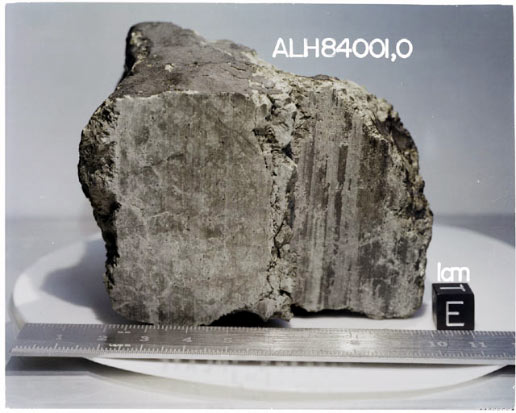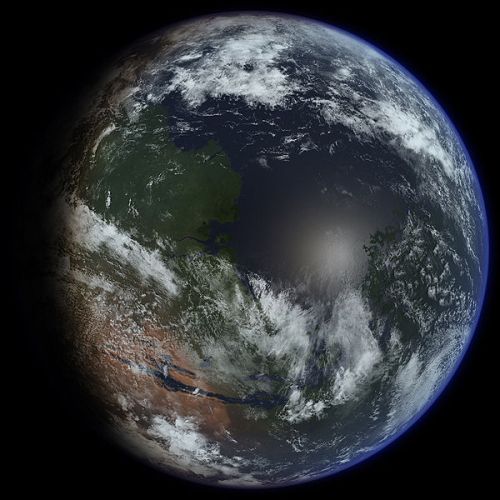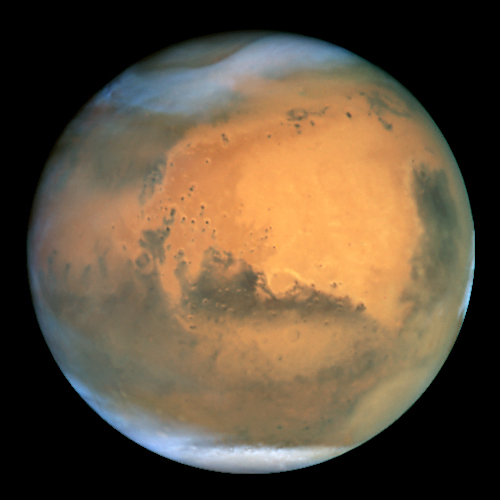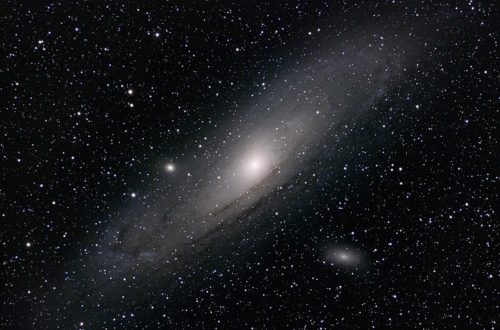Possibilities for Life on Mars
An article was recently published by Scientific American, a very reputable science magazine, stating that evidence was found that life existed on Mars and was brought to Earth on a meteorite. The meteorite in question is called “Allan Hills 84001”. It was blasted from Mars by a huge meteorite impact 16 million years ago and crashed on Earth 13,000 years ago. It was only in 1996 that it was discovered in Antarctica. The meteorite appeared to contain some peculiar fossils. They being of biological nature was rapidly dismissed at the time. However, now scientists have re-examined them and concluded that they are indeed biological. They are fossils of ancient microscopic aliens!
 Meteorite from Mars with biological fossils in it.
Meteorite from Mars with biological fossils in it.
Technology has improved in the past 13 years, and now with much more advanced high resolution electron microscopy, carbonate discs and tiny magnetite crystals have been found in the meteorite. According to NASA scientists, the carbonate discs are evidence of interaction with water on Mars over 3.5 billion years ago. This means the rock formed during a period called the Noachian epoch when Mars was covered by vast oceans. Mars was very much like the Earth is today. According to the NASA scientists in charge of the project, the fossils and the carbonate disks are “intimately associated within and throughout”. Therefore, this means that the fossils are not the remains of Earth microbes that contaminated the meteorite during the 13,000 years it was laying on Antarctica.
All this suggests 5 possible explanations:
- This is all a mistake, and those fossils are not biological.
- Life first evolved on Earth and then it was brought to Mars on a meteorite blasted off Earth. It survived long enough on Mars to spread all over the planet. Then 16 million years ago a meteorite was blasted off Mars and ended up on Earth, with the life on it returning to its home planet. Since then life could have either disappeared completely from Mars, or only microscopic organisms survived alone.
- Life first evolved on Mars and then it was brought to Earth on a meteorite. Since then life could have either disappeared completely from Mars, or only microscopic organisms survived alone.
- Life first evolved somewhere else and was brought to both Earth and Mars by meteorites and comets. (The panspermia theory.)
- Life evolved separately on both Mars and Earth. (A very unlikely theory, in my opinion.)
 Mars how it could have looked during the Noachian epoch if it had life, versus how it looks now.
Mars how it could have looked during the Noachian epoch if it had life, versus how it looks now.
(Credits: 1st image by Wikipedia user Ittiz; 2nd image by Hubble Space Telescope)

It is also interesting to add that we could have recently contaminated Mars (and possibly other planets) by all the probes and landers we have sent. Since Mars is the most hospitable planet for life after Earth, and bacteria are very resilient creatures, it is logical to assume that they would have survived on Mars and adapted to the new environment. So even if life on Mars became extinct since the meteorite was blasted off the Martian surface, it has now possibly returned!
What do you think? Let me know in the comments section!
Would you like to receive similar articles by email?






11 Comments
C. C.
Does anyone have a reasonable explanation as to why we dont have large meteor impacts in the “recent” era? There has been speculation that such impacts come in cycles – albeit relatively huge in terms of years – but you have to stop and think about the catastrphic potential.
Drachus
Wait wait wait… so you’re using an equation that was developed on the assumption of only one life-bearing planet to judge the viability of another life-bearing planet’s existence before that equation ever existed (and indeed, independently of its worth as an equation)?
Something in the logic doesn’t compute there. A predictive equation doesn’t translate into a law of reality… The fossils themselves could be interpreted as stark evidence against the current Drake equation, so utilizing that dubiously useful predictive equation to assess this situation is a slightly less than reasonable.
Dave
An overly simplified explanation of why it’s improbable that life evolved independently on both Earth and Mars: If the fraction of planets able to sustain life developing life is 0.000001 (A likely generous estimate), then the probability of life evolving on both is 0.000001*0.000001 = .000000000001. That’s why. Note, this does not include the possibility that life was seeded on both planets from elsewhere. This only includes the possibility that life spawned (originated) on each planet on it’s own. However, if all planets that are able to sustain life at some point indeed do, then it becomes 1*1 = 1. A certainty. We just don’t know what that proportion really is. The sample size at this point is just to small (2 viable planets, 1 we know has life, the other is unknown). Which is why this is such a debatable question.
Paul Tomaszewski
Thanks for the comment! 🙂
This is a good mathematical approach to the probability of life evolving on its own on both planets.
Keith
I also have a question about the improbability of scenario 5. From someone with still relatively young high level education in science (a second year science major), i was wondering why it would be so unlikely because it seems to me if mars had the environment to house life 16 million years ago, that microscopic could have evolved on both planets separately. unless of course they are similiar.
Paul Tomaszewski
Of course it’s possible, but in my opinion it’s still rather improbable, as I explained in the previous comment (the one mentioning the Drake equation).
Paul Tomaszewski
And btw thanks for the comments. I’m still open to suggestions for other possible scenarios than the 5 mentioned above.
Paul Tomaszewski
Because of the high improbability of life to appear on one planet in a single system, let alone two. Even with the optimistic odds of the Drake equation for microbial life, it is still very unlikely for life to evolve separately on two planets in a single system.
However this is only a question of odds, not impossibilities. Therefore, scenario 5 is still a valid hypothesis, however in my opinion it is quite unlikely. Though all that could change if new evidence is found and the Drake equation is revised.
Paul Tomaszewski
4 billion years ago, meteoroid impacts were very common. It’s actually very probable for such exchanges of rocks with possibly microscopic lifeforms who tagged along for the ride. Also, I’m pretty sure that the Allan Hills 84001 meteoroid is not the only one that came from Mars and crashed on Earth in the past few million years. So it would make sense to believe that the same thing could have possibly happened in the other direction.
MisterTotality
We know life has been present on Earth for the last 4 billion years. Regarding scenario 2 above, while it is true that both Earth and Mars have been impacted numerous times, it is terribly unlikely that fragments from the two planets could be passed back and forth by chance. Why does the author find it “very unlikely” that life evolved separately on both planets?
Dan
I would love to see some form of evolution happening on other planets. Even if were in the form of plant life.